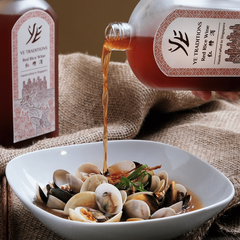Difference between Red Rice Wine and Yellow Rice Wine
Many people ask us: What is the difference between Red Rice Wine (Hong Zao 红糟酒) and Yellow Rice Wine (黄酒)? Are they used as cooking wine? Which should I use for confinement wine? What are the different health benefits? While these wines have a similar brewing process, these iconic brews are very unique, and offer a spectrum of flavors and benefits.

Rice Wine Benefits
We have a whole article on rice wine benefits, but in short, rice wine, regardless of the variant, is a probiotic and helps with digestion. Just like kimchi, yogurt, or kombucha, which are more well-known as a probiotic, similarly, rice wine is also an amazing probiotic because of its natural fermentation process.
Apart from that, according to TCM, it also helps promote blood circulation, making it an ideal health tonic for the elderly and people recovering from illness.
The Vibrant Complexity of Red Rice Wine (Hong Zao)
Diving into each variant of rice wine: Hong Zao or Red Rice Wine, is a gem in the crown of Chinese fermentation arts, celebrated for its rich, vibrant hue and complex flavor profile. Originating from the traditions of eastern China, particularly in regions like Fujian and Zhejiang, Hong Zao is made from glutinous rice fermented with red yeast rice, which imparts its distinctive color and a slight sweetness.
Different from other varieties, Red Rice Wine has red yeast rice added to it. And there are many scientific studies done in Western and Chinese medicine about the benefits of red yeast rice, the most popular one being that it lowers blood cholesterol. You can do a quick google search and learn more about it if you want to get nerdy about the scientific papers. Because of this, red rice wine is very popular among the elderly or those who are more health conscious.
We learned our formula from our grandmother who is from Fuzhou, in Fujian Province. This fermentation process not only creates a wine with a deep, nuanced taste but also imbues it with a variety of health benefits, including what we mentioned earlier, improved circulation and digestion.
Culinary Applications of Hong Zao
It is a staple in many Chinese kitchens, where it's used to marinate meats, enhance soups, and create sumptuous sauces. It can be used as a replacement to Shaoxing wine as a cooking wine. Its subtle sweetness and depth of flavor make it an ideal ingredient for dishes like Hong Zao chicken, where the wine melds with ginger to produce a dish of comforting warmth and richness.
Taste Profile of Hong Zao
It is not straightforward to describe the taste of red rice wine, because everyone has different taste buds, so let me attempt to describe how it is based on how the majority of customers describe it. Compared to yellow rice wine, which I will share below, red rice wine is thicker and bolder in taste. Some like the richness and slight tartness to it. They also find it less sweet compared to yellow rice wine.
The Golden Elegance of Yellow Rice Wine
If we say that Red Rice Wine is the bold and adventurous family member, Yellow Rice Wine is the more delicate member who can still stand on its own with its elegance. Traditionally consumed by the Hakka people in southern China, Hakka yellow wine is made using a unique strain of yeast that ferments the glutinous rice, yielding a wine that is milder and slightly sweet.
Culinary Applications of Hakka Yellow Rice Wine
The wine's gentle flavor makes it not only a delightful drink but also a versatile cooking ingredient, often used in steaming and braising to add a touch of sweetness and complexity to dishes. For example, the popular Hakka Yellow Wine Chicken is a classic dish using this wine. You can even cook Drunken Chicken (醉鸡) and we have the recipe here too. In our family, we also use it for marinades and a substitute for Hua Diao or Shaoxing wine, as our version has no added salt nor sugar.
Taste Profile of Yellow Rice Wine
Yellow rice wine, to the uninitiated, is more popular because it has a sweeter, lighter taste. This makes it an excellent introductory rice wine to those who are new to the world of rice wine. However, this again depends on what "sweetness" means to you. For me, I prefer red rice wine because I don't like sweets in general. But for so many others, this is their go-to rice wine.
An easy side by side comparison
| Feature | Hong Zao (Red Rice Wine) | Yellow Rice Wine |
|---|---|---|
| Origin | Eastern China, especially Fujian and Zhejiang regions. Most popular in Fuzhou, within Fujian province, and that's why you will hear of it as "Fuzhou Hong Zao" as well. | Southern China, closely associated with the Hakka community. |
| Base Ingredient | Glutinous rice fermented with red yeast rice, which gives it its distinctive red color. | Glutinous rice, fermented with a unique strain of yeast specific to the Hakka recipe. |
| Color | Vibrant red, owing to the red yeast rice. This is all natural. | Pale yellow, reflective of the natural fermentation process without any red yeast rice. |
| Flavor Profile | Rich and complex, with a subtle sweetness and depth. | Mild, slightly sweeter, with a delicate complexity. |
| Health Benefits | Believed to improve circulation and aid in digestion. | Associated with similar health benefits, including aiding digestion and providing a source of antioxidants. |
| Culinary Uses |
Most popular: Hong Zao Chicken Soup Widely used in marinating meats, enhancing soups, and creating rich sauces. |
Most popular: Hakka Chicken Soup Often used in steaming and braising dishes, adding a touch of sweetness and depth. |
| Cultural Significance | Integral to traditional Chinese cooking and celebrations, symbolizing warmth and richness. | Deeply embedded in Hakka traditions, symbolizing unity and joy during communal gatherings and festivals. |
What About Confinement Rice Wine?
Many moms also ask us which is more suitable as a confinement rice wine - Red Rice Wine, Bentong Ginger Wine, or Yellow Rice Wine, and we definitely would leave them up to your personal preference since you will be consuming them for a month and we want to make sure you enjoy them.
However, many confinement nannies would prefer their mothers to use either Bentong Ginger Wine (to remove post-pregnancy wind, especially with our more potent Bentong Ginger) or Red Rice Wine (touted by TCM to be beneficial in blood circulation). You won't go wrong with any of the options, so pick the one that fits your taste buds the most!







Leave a comment